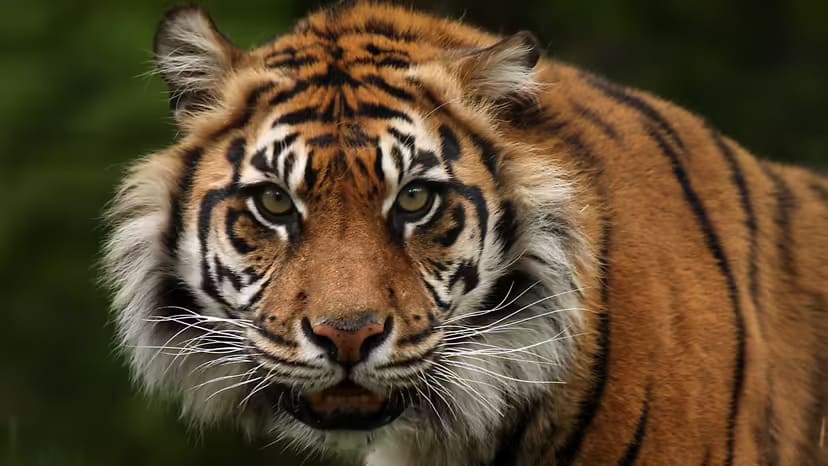Who it is: The Sunda tiger—better known as the Sumatran tiger (Panthera tigris sumatrae)—is the smallest living tiger subspecies, now confined to Indonesia’s Sumatra and listed as Critically Endangered.
What’s driving the decline: Rapid forest loss and fragmentation, poaching and illegal trade, and escalating human–tiger conflict.
What’s working: Protected‐area networks, anti-poaching patrols, community co-management and alternative livelihoods, plus long-term monitoring with camera traps, genetics and satellite data.
What’s next: Expand connected “tiger conservation landscapes,” strengthen law enforcement along the entire trade chain, reduce conflict, and fund decade-long monitoring to guide action.
“Sunda” refers to the biogeographic Sunda Islands. Historically the group included Javan and Balinese tigers—both now extinct—leaving the Sumatran tiger as the only surviving “Sunda” tiger. It is highly adapted to dense tropical rainforest.

Body plan: The smallest tiger; males typically 100–140 kg, females lighter. Compact build and strong forequarters for maneuvering through understory.
Coat: Deeper orange base color with narrower, denser stripes—excellent dapple-light camouflage.
Mane fringe & whiskers: A subtle neck ruff and long, highly innervated vibrissae aid distance-judgment in dark, tight spaces.
Ecological role: Apex predator and both an umbrella and flagship species—its protection safeguards whole forest systems.
Prey: Deer species, wild pigs, macaques, and small aquatic vertebrates; opportunistic.
Tactics: Stealth and short-burst ambush, not long chases; burst speeds up to ~64 km/h.
Energetics: A single large kill can sustain an adult for roughly a week, reducing risky search time.
Forest decline: From 58% cover in 1985 to 26% by 2014 across Sumatra, driven by oil-palm expansion, illegal logging and infrastructure.
Fragmentation effects: Suitable habitat has become “islands,” isolating subpopulations, depressing gene flow and fitness, and pushing edge areas—and tiger–human encounters—upward.
Connectivity focus: Conservation prioritizes core–buffer–corridor design linking Leuser, Ulu Masen, Kerinci Seblat, Berbak–Sembilang, and Bukit Barisan Selatan landscapes.
Targets: Bones, skin, teeth, claws and whiskers for décor and traditional products.
Why it persists: Cross-border networks and high margins.
What helps: Community intelligence, SMART-based patrol planning, stronger evidence chains and cross-jurisdiction prosecution to choke profit at source, transit and market.
Why it happens: Prey depletion and shrinking habitat push tigers toward farms and village edges; livestock losses spark retaliatory killing.
What reduces risk:
Alternative livelihoods (sustainable agro-products, honey/coffee/spices, ecotourism);
Livestock protection (secure enclosures, lighting, deterrents, supervised night pens);
Compensation/insurance to align local incentives;
Rapid conflict-response teams for non-lethal interventions and community support.
Protected areas plus co-managed community forests, with corridors to keep high-quality habitat contiguous and functional.
Routine SMART patrols to remove snares and record incidents;
Full-chain enforcement to pursue financiers and brokers, not just field poachers;
Judicial training and model sentencing to increase deterrence.
Share conservation dividends (ranger jobs, guiding, eco-products), scholarships, and school programs to convert fear and skepticism into local stewardship.
Camera-trap grids to estimate abundance, home ranges and movement corridors;
Genetics/eDNA to assess relatedness and inbreeding risks;
Remote sensing to track forest loss, fire and road growth;
Stripe-pattern ID databases to follow individuals over years.
Reconnect the fragments so tigers can move and genes can flow.
Reduce preventable deaths by cutting snares, trade demand and conflict.
Fund long-horizon monitoring—consistent data over 10+ years to steer adaptive management.
Keep people central so communities benefit as forests and tigers recover.
Support credible, long-term in-country conservation programs (patrols, education, corridor restoration).
Choose products with deforestation-free certifications (e.g., RSPO) to shrink pressure on primary forests.
Share science-based information and reject any tiger products or “trophy” tourism that fuels harm.
What is the top threat to the Sunda tiger today?
Landscape-scale habitat loss and fragmentation are the primary drivers, compounded by poaching/illegal trade and human–tiger conflict.
How can local communities help?
By joining patrols and tip networks, adopting alternative livelihoods, securing livestock, and partnering with rapid conflict-response teams—turning conservation into a net benefit for households.
The Sunda tiger is the living emblem of Sumatra’s last great rainforests. Protecting it means protecting the vast, interconnected web of species and services those forests provide. With science as the backbone, law and communities as the levers, and patience as strategy, we can bend the curve from decline toward recovery.
animal tags: Sumatran Tiger
We created this article in conjunction with AI technology, then made sure it was fact-checked and edited by a Animals Top editor.